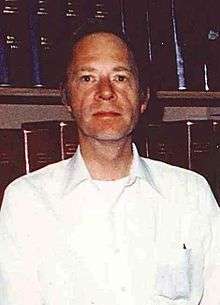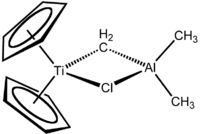Frederick N. Tebbe
| Frederick Nye Tebbe | |
|---|---|
 Fred Tebbe in late 1980 | |
| Born |
March 20, 1935 Oakland, California |
| Died |
September 28, 1995 (aged 60) Hockessin, Delaware |
| Nationality | USA |
| Fields | Organometallic Chemistry |
| Institutions | DuPont Central Research |
| Alma mater | Pennsylvania State University, University of Indiana |
| Thesis | Studies of Interconversions of Boron Hydrides (1963) |
| Doctoral advisor | Riley Schaeffer |
| Known for | Tebbe's reagent, borane chemistry |
| Influences | George Parshall |
| Influenced | Richard Schrock |
| Spouse | Margaret Manzer |
Frederick Nye Tebbe was born in Oakland, California on March 20, 1935. His father, Charles L. Tebbe, worked for the United States Forest Service so Fred’s early education took place in Montana, Oregon, Maryland and Pennsylvania. He married Margaret Manzer in 1960, and they had a son (Andy, born in 1966) and a daughter (Sarah, born in 1971). He died of pancreatic cancer at his home in Delaware on September 28, 1995.
Education
Fred obtained a bachelor's degree in chemistry from Pennsylvania State University. His senior research focused on the synthesis of diboron tetrachloride from BCl3 and Hg discharge cells under the direction of Professor Thomas Wartik. Wartik encouraged Fred to join the group of Professor Riley Schaeffer at Indiana University. Instead, Fred spent a year at Montana State University studying psychology and philosophy: After this interlude and thoughts of going into Forestry, Fred finally decided to join Schaeffer at Indiana.
The area of borane chemistry was growing rapidly, in part due to the Cold War and national security interests. In addition to the synthesis of pyrophoric and explosive compounds, Fred used 10B NMR spectroscopy to understand the mechanism of the aggregation of boranes into the homologs B4H10, B5H9, and B5H11. He demonstrated that 10B-enriched diborane in diethylether rapidly exchanges all ten boron positions in the anion B10H13−.[1] His dissertation, “Studies of Interconversions of Boron Hydrides,” was completed in 1963.
Fred did two years of postdoctoral work with Professor Fred Hawthorne at the University of California, Riverside. During that time, he greatly expanded the range of known carboranes to include polyhedral B9C2H11, B8C2H10, B7C2H9, and B6C2H8 carboranes, the B7C2H13 system, and their derivatives.[2][3][4]
DuPont career
In the fall of 1965, Fred was hired by Earl Muetterties in DuPont Central Research Department, where he worked in the group of George Parshall. Earl was known to have quite broad interests and he enticed Fred to work in a variety of new areas. NMR investigation of stereochemical nonrigidity in five- six- and seven-coordinate molecules was under active study and Fred contributed to a number of those studies.[5] Herbert Roesky was in CR&D at the time and thru their sulfur chemistry,[6][7] he and Fred established a lifelong friendship.
Fred began his work with Parshall on early-transition metal hydrides and the behavior of organoaluminium and organozinc reagents with early transition metal complexes. The goal of the research was to better understand heterogeneous Ziegler-Natta catalysts by independently understanding the roles of the transition metal and the aluminum alkyl promoter thru more well-defined homogeneous analogs. The first paper was on the catalysis of aromatic hydrogen-deuterium exchange by metal hydrides. This was followed by a paper on hydride derivatives of niobocene and tantalocene. The two break-through papers on olefin homologation with titanium methylene compounds[8] and titanium-catalyzed olefin metathesis[9] appeared in 1978 and 1979 respectively, though the seminal work was recorded in Fred’s notebook in July 1974 (See Figure 2 in Scott and Mindiola’s tribute).[10]

It should be noted that in his autobiography written upon receipt of the 2005 Nobel Prize in Chemistry, Dick Schrock reminisced fondly of his short time at DuPont (1972–1974) when he shared his lab space with Fred. Schrock’s synthesis of (tBuCH2)3Ta=CHtBu, the first Lewis acid-free alkylidene that ultimately led to his Nobel Prize was concurrent with the synthesis of Tebbe’s Reagent that took place just feet away. It was another Nobel Prize winner, Bob Grubbs, who named the Tebbe Reagent after Fred.[11]
In related studies, Fred was involved in the development of catalysts for polyethylene and elastomeric polypropylene using alumina-supported bis(arene) titanium, zirconium and hafnium catalysts[12] and tetraalkyl titanium, zirconium and hafnium catalysts.[13] Fred also spent time working in the area of ceramic materials. His work on thermoplastic organoaluminum precursor of aluminum nitride allowed spinning of the precursor into fibers before sintering into aluminum nitride fibers. Aluminum alkyls allowed the preparation of aluminum hydroxide and alumina with ultra-low alpha-particle emission, suitable for ceramic memory-chip substrates for aerospace and satellite electronics.[14]
To finish his career, Fred returned to fundamental studies of the elements. His work on the structure of sulfur in solution[15] and on buckminsterfullerene[16][17] are highly cited.
Fred has been described as a quiet individual with a self-deprecatory personality. Instead, this may have been the outward manifestation of his introverted personality. He often deferred invitations to chemical conferences or seminars around the world because he was more comfortable in his lab. In the presence of friends, he was a lively speaker who on more than one occasion interchanged his chalk and his cigarette while excitedly describing recent results at a blackboard. Fred played a very positive role as a mentor, influencing the careers of young chemists in the organometallic group. He was incredibly generous in sharing his time and expertise with younger colleagues who commented on the good fortune of those who were lucky enough to become Fred's lab partner. After 33 years of dedicated work, Fred retired from DuPont in 1993 just as DuPont’s No-Smoking policies went into effect.
References
- ↑ An unusual boron exchange reaction, Schaeffer, Riley; Tebbe, Fred N. Journal of the American Chemical Society (1963), 85(13), 2020-1.
- ↑ Thermal isomerization of C-phenyldicarbaundecaborate(12), Garrett, Philip M.; Tebbe, Fred N.; Hawthorne, M. Frederick, Journal of the American Chemical Society (1964), 86(22), 5016-17
- ↑ The B6C2H8, B7C2H9, and B8C2H10 carborane systems, Tebbe, Fred N.; Garrett, Philip M.; Young, Donald C.; Hawthorne, M. Frederick, Journal of the American Chemical Society (1966), 88(3), 609-10.
- ↑ Preparation and characterization of the (3)-1,2- and (3)-1,7-dicarbadodecahydroundecaborate(-1) ions, Hawthorne, M. Frederick; Young, Donald Clifford; Garrett, Philip M.; Owen, David A.; Schwerin, Sarah G.; Tebbe, Fred N.; Wegner, Patrick A. Journal of the American Chemical Society (1968), 90(4), 862-8.
- ↑ Stereochemically nonrigid six-coordinate hydrides, Tebbe, Fred N.; Meakin, P.; Jesson, J. P.; Muetterties, E. L., Journal of the American Chemical Society (1970), 92(4), 1068-70.
- ↑ New sulfur chelate chemistry, Tebbe, Fred N.; Roesky, Herbert W.; Rode, W. C.; Muetterties, E. L. Journal of the American Chemical Society (1968), 90(13), 3578-9.
- ↑ Thiophosphate chemistry. Anion set X2PS2−, (XPS2)2S2−, and (XPS2)2S22− Roesky, Herbert W.; Tebbe, Fred N.; Muetterties, Earl L. Inorganic Chemistry (1970), 9(4), 831-6.
- ↑ Olefin homologation with titanium methylene compounds, Tebbe, F. N.; Parshall, G. W.; Reddy, G. S. Journal of the American Chemical Society (1978), 100(11), 3611-13.
- ↑ Titanium-catalyzed olefin metathesis, Tebbe, F. N.; Parshall, G. W.; Ovenall, D. W. From Journal of the American Chemical Society (1979), 101(17), 5074-5
- ↑ A tribute to Frederick Nye Tebbe. Lewis acid stabilized alkylidyne, alkylidene, and imides of 3d early transition metals Jennifer Scott and Daniel J. Mindiola Dalton Trans., 2009, 8463-8472
- ↑ T. R. Howard, J. B. Lee and R. H. Grubbs, J. Am. Chem. Soc., 1980,102, 6876–6878
- ↑ Polyethylene and elastomeric polypropylene using alumina-supported bis(arene) titanium, zirconium, and hafnium catalysts, Tullock, Charles W.; Tebbe, Frederick N.; Mulhaupt, Rolf; Ovenall, Derick W.; Setterquist, Robert A.; Ittel, Steven D., Journal of Polymer Science, Part A: Polymer Chemistry (1989), 27(9), 3063-81
- ↑ Stable solutions of tetra(hydrocarbyl)metal compounds and use thereof for catalyst preparation Ittel, Steven D.; Tebbe, Frederick N. From U.S. (1993), US 5192730 A 19930309.
- ↑ Purity of aluminum hydroxide derived from triethylaluminum, Tebbe, Fred N.; Morris, Patricia A.; French, Roger H.; Chowdhry, Uma; Coble, Robert L. Journal of the American Ceramic Society (1988), 71(4), C204-C206. Preparation of aluminum hydroxide and alumina with ultra-low alpha-particle emission, suitable for ceramic memory-chip substrates, Tebbe, Frederick Nye Eur. Pat. Appl. (1988), EP 293247 A1 19881130.
- ↑ Composition of elemental sulfur in solution: equilibrium of S6, S7 and S8 at ambient temperatures, Tebbe, Fred N.; Wasserman, E.; Peet, William G.; Vatvars, Arturs; Hayman, Alan C. Journal of the American Chemical Society (1982), 104(18), 4971-2.
- ↑ Multiple, reversible chlorination of C60, Tebbe, Fred N.; Becker, James Y.; Chase, D. Bruce; Firment, Lawrence E.; Holler, Edward R.; Malone, Brian S.; Krusic, Paul J.; Wasserman, E., Journal of the American Chemical Society (1991), 113(26), 9900-1.
- ↑ Synthesis and single-crystal x-ray structure of a highly symmetrical fullerene (C60) derivative, brominated fullerene (C60Br24), Tebbe, Fred N.; Harlow, Richard L.; Chase, D. Bruce; Thorn, David L.; Campbell, G. Creston, Jr.; Calabrese, Joseph C.; Herron, Norman; Young, Robert J., Jr.; Wasserman, E. Science (Washington, DC, United States) (1992), 256(5058), 822-5.
External links
| Wikimedia Commons has media related to Frederick N. Tebbe. |